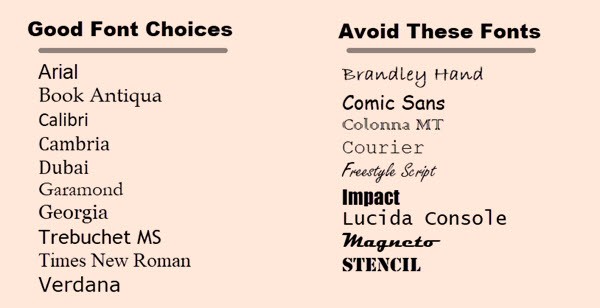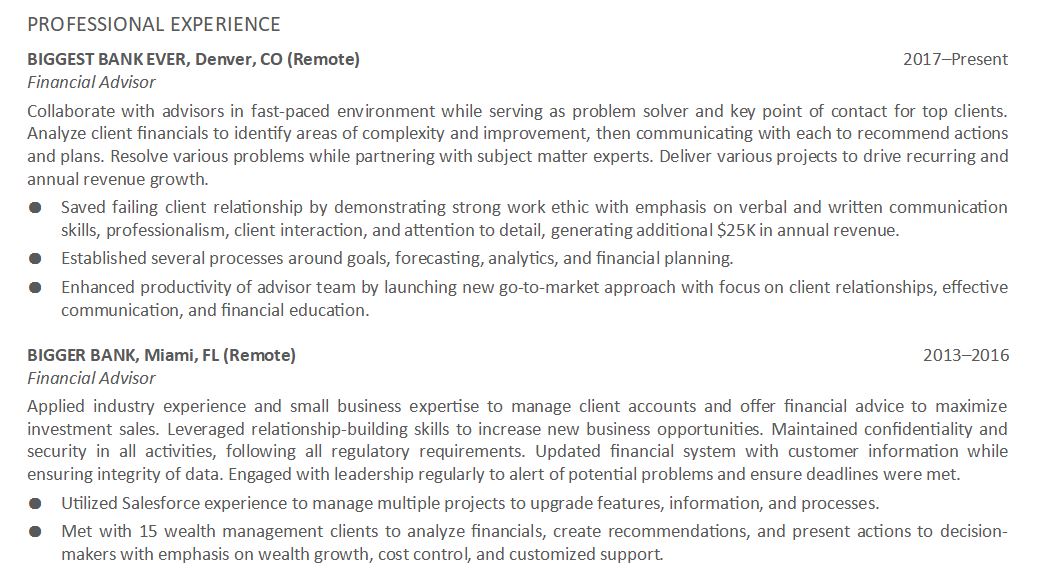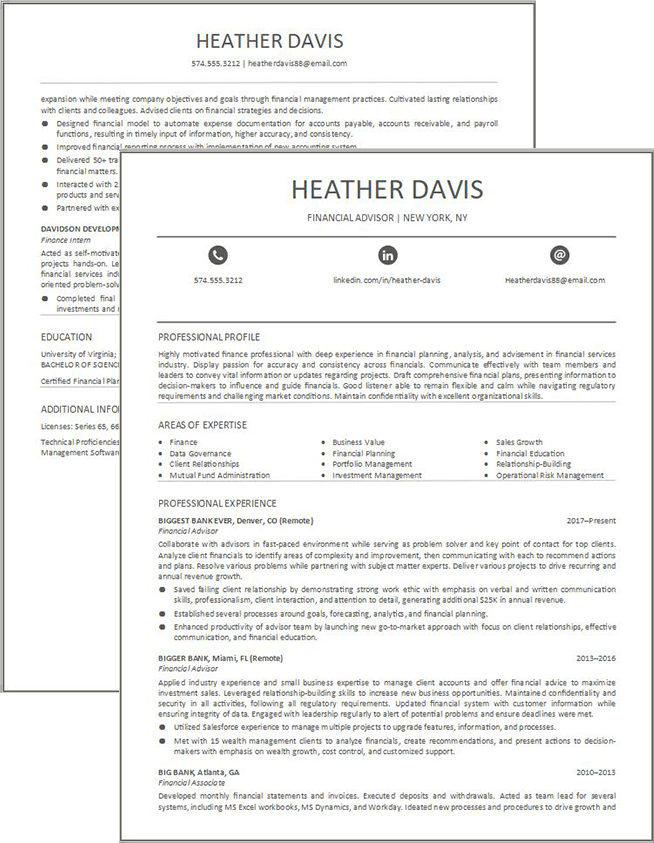Financial Advisor Resume Guide

As you begin your next job hunt, a professional resume is crucial, whether you are an experienced financial advisor or just looking to move up in your career.
This will serve as your guide to walk you through all the important steps needed to master your financial advisor resume writing process.
And if you prefer to download and purchase the full financial advisor resume template, you can get it here.
About Financial Advisor Resumes
As a successful professional, you know the value that you bring to organizations and what sets you apart from your peers. You know your strengths and can speak to them, but when it comes to drafting a resume, you find it difficult to express all of this in a concise, organized, and compelling way. You know what you want your next challenge to be, but you’re unsure how to go about targeting your resume to be noticed by potential employers.
The first step to the resume-writing process is to take an objective look at your career and form a narrative: How did you get where you are? What accomplishments were critical to your success? What qualities make you an asset to the culture and success of an organization? The next step is to research current industry trends and the attributes that employers are looking for. If you considering a move to a different industry, reflect on the transferable skills you can leverage in describing your experience and accomplishments in your resume.
In the financial industry, it’s important to not only highlight your financial expertise but also the variety of soft skills needed to succeed. You want to create a narrative that shows your career progression and successes while also showcasing the skills that got you to where you are.
The next step is to craft a resume that highlights those skills and attributes that differentiate you from the competition while communicating this information concisely and convincingly. Although there are general guidelines that professional resumes should follow, some industries have differing standards regarding length, language, and inclusion of additional information such as publications. Our team of career advancement experts is well-versed in navigating these idiosyncrasies and drafting professional resumes that establish your brand and optimize the presentation of your experience.
After reading this guide and viewing our sample resumes, you might choose to take advantage of a professional resume writing service and save significant time that can be better used to review potential job opportunities and expand your network.

The Financial Advisor Resume
Job searching can be difficult for professionals at all levels. As technology and the workforce evolve, you must apply new tactics to how you search for jobs. Strategizing is important to get noticed and secure an interview. Many companies use applicant tracking system (ATS) software to screen resumes. So, it’s more important than ever to research and prepare for your job search to ensure your resume passes the initial scan.
When you have researched the job market and developed a firm understanding of the expectations of potential employers, you can strategize about how best to present your previous work history. It’s vitally important to think about how an outside reader will read your resume and ensure that there is a consistent narrative woven throughout the document. Think of what aspects each role contributed to where you are now. What were your major achievements? What did they deliver to the company? This paints a picture in the minds of potential employers about what you can uniquely contribute to their organization.
The key to a compelling resume is that it is detailed and demonstrates a clear progression of your achievements. The document should also be clean and concise. Some general stylistic guidelines to a perfect resume include:
- Aesthetic Appeal: Without considering the content, the resume should look appealing and draw the reader in. Ensure consistent spacing and formatting throughout.
- Eye-Catching Introduction: Within the first few lines of the resume, it should be clear what unique value you bring to an organization. This is communicated within the executive summary that begins the resume.
- Highlighted Achievements: Your notable accomplishments should be discussed in detail throughout the resume and supported by data-driven evidence that communicates the contributions of these achievements.
- Attention to Detail: Your document should be free of any formatting, spelling, or grammatical errors that can distract the reader from the strength of the narrative. Additionally, word counts are critical to keeping the resume concise, so articles such as “a” and “the” are omitted. You should also avoid the use of pronouns as these add to the word count.
- Readability: It should go without saying that your resume might be viewed by a variety of readers, some of whom might not be in your industry. You should avoid overly technical language and spell out all acronyms on their first appearance. Although you might assume that everyone knows what a specific acronym represents, don’t be so certain!
A financial advisor resume is easy to follow with engaging language that shows the actions you’ve taken throughout your career to achieve your successes. It should have a professional layout with 10-15 years of experience highlighted.

Presenting the Financial Advisor Resume
The most effective and appealing resumes have relatively simple, but elegant, formatting. Although you may see some fanciful resume designs, these can detract from the intended impact of the resume’s content. When it comes to resume-writing, less is more. This means that the resume should only be 2 pages maximum and ideally fewer than 1000 words.
That being said, there is also often the temptation to present your resume in a flashy way thinking that it will attract more attention. It probably will, but not in the way that you might like. The reality is that this strategy often has the opposite effect—busy hiring managers have limited time to evaluate a resume, and they need to be able to quickly make a judgment as to whether your resume moves forward. Overly complex designs or formatting that obscures key information can sabotage your resume’s chances of being seriously considered by potential employers.
Your resume should be a reflection of your achievements, so it’s best that your design is organized and efficient. A professional resume is both easy to read and professional. Let your accomplishments shine in the document rather than a distracting design.
It’s important to keep in mind what the recruiter or potential employer sees when viewing the resume from a purely aesthetic vantage point. This is why the strategic use of white space is essential. A clean design, with well-presented information that can quickly and easily be scanned, is the goal of a professional resume.
The design of your document should be organized and neatly formatted with clearly defined sections, clear titles for section headings, bold job titles, clean fonts, concise job descriptions, and bulleted achievements. Additionally, you should avoid using a photograph or any excessive color or graphics, as these can distract from the content. If you feel the need to be creative, direct it towards writing your career success story—sell yourself through your achievements.

We‘ll discuss how to create each of these sections below.
Contact Information
It goes without saying that your contact information is vital to ensuring an employer can easily reach out to you following a successful first screening of your resume. This information should be presented at the very top of the resume as in the example below:

You’ll notice a few things:
- Only your city and state are listed.
- Select only one email address, and this should preferably be a personal email rather than one affiliated with your current position.
- List your LinkedIn profile URL to provide another potential means of an employer reaching out to you and to present yourself as an established professional with a personal brand.
- Include your phone number as an alternative means of outreach.
Your Job Title and Summary
The job title at the top of your resume should be the title to which you are applying and not necessarily your current position. Remember that you are drafting this document to target your next challenge. This is a section that you may need to customize depending on the position to which you’re applying, and ATS systems will often deduct points if the position listed in the resume does not match the job description.
Many studies have shown that hiring managers only read the first few sentences of a resume prior to deciding whether to continue reviewing it, which means that the opening lines of your resume need to be impactful. Directly following the job title is the professional summary, which begins with your unique value proposition (UVP) or elevator pitch. The unique value proposition describes your most significant accomplishments and how they have positioned you for your next challenge. Use descriptive language that clearly and precisely defines who you are and what singles you out from your peers.
For example, this is a sample UVP for a financial advisor resume:
Highly motivated finance professional with deep experience in financial planning, analysis, and advisement in financial services industry.
Using the UVP as a foundation, write 3-5 sentences that discuss key attributes that are both unique to you and align with the targeted role. Use direct, active language that says what you contribute and how it drove success for the organizations in which you have been a key player. This communicates to potential employers what skills and achievements you can leverage to support their growth and strategic vision.
For example, your financial advisor summary may look similar to this one:
Highly motivated finance professional with deep experience in financial planning, analysis, and advisement in financial services industry. Display passion for accuracy and consistency across financials. Communicate effectively with team members and leaders to convey vital information or updates regarding projects. Draft comprehensive financial plans, presenting information to decision-makers to influence and guide financials. Good listener able to remain flexible and calm while navigating regulatory requirements and challenging market conditions. Maintain confidentiality with excellent organizational skills.
If you’re having difficulty narrowing down what to focus on in your professional summary, review the descriptions of your targeted role and select those that match your skills in language and scope. Research what companies are looking for in your potential role to craft your UVP and customized professional summary. Think about both hard skills that describe your abilities and soft skills that describe your personal attributes.
As always with resumes, avoid wordy or flashy language and utilize industry-specific keywords whenever possible. Not only does this help to target the resume for your desired role, but it also reinforces that you are knowledgeable about your field.

Keywords
As you craft the professional summary, it’s important to understand the importance that keywords play in aligning your resume with both the specific role to which you are applying and the industry at large. It can’t be emphasized enough that even the most qualified candidates might not make it to the interview stage because their resume didn’t score high enough on a potential employer’s ATS to make the cut. To avoid this and optimize your resume language, review the job description, and select the keywords and phrases that align with the role.
Additionally, there are also skills and attributes that every professional within the financial industry are expected to possess, as well as specific types of accomplishments that stand out. Below is a table of keywords that are common within the financial industry. This list is by no means comprehensive and should complement the list you generate from reviewing job descriptions.
Hard skills:
- Financial planning
- Analysis
- Financial advisement
- Financial services
- Regulatory requirements
- Data governance
- Client relationships
- Mutual fund administration
- Business value
- Portfolio management
- Investment management
- Sales growth
- Financial education
- Operational risk management
Soft skills:
- Relationship-building
- Problem-solving
- Written and verbal communication skills
- Organizational skills
- Presentations
- Flexibility
- Confidentiality
Areas of Expertise (Skills and Competencies)
Now that you have compiled a list of keywords that can be incorporated into the document, you can start drafting the next section of the resume by listing 6–10 bulleted areas of expertise. Try to match these with phrasing in the job description as ATS systems scan for verbatim matches. If, for example, the description says artificial intelligence, don’t use AI. Spell out the phrase and define the acronym like this: artificial intelligence (AI). Additionally, this list can be a combination of both hard and soft skills.

- Finance
- Data Governance
- Client Relationships
- Mutual Fund Administration
- Business Value
- Financial Planning
- Portfolio Management
- Investment Management
- Sales Growth
- Financial Education
- Relationship-Building
- Operational Risk Management
With these areas in mind, think about how they can be emphasized throughout the resume. Furthermore, if you have a few high-level, data-driven achievements that you would like to showcase upfront, these can be included in a notable accomplishments section following the areas of expertise. If you choose to do this, make sure these specific achievements are not duplicated later in the document. Always remember, in resumes, less is more!
- Saved failing client relationship by demonstrating strong work ethic with emphasis on verbal and written communication skills, professionalism, client interaction, and attention to detail, generating additional $25K in annual revenue.
- Established several processes around goals, forecasting, analytics, and financial planning.
- Enhanced productivity of advisor team by launching new go-to-market approach with focus on client relationships, effective communication, and financial education.
Employment History/Professional Experience
This section is the canvas on which you can expand on your professional summary and UVP to describe the details of your career history. Although it does include descriptions of your responsibilities position-by-position, it should be presented in a way that reflects the evolution of your career in a clear, concise way and in reverse chronological order. In addition, you should limit the scope of your presented career to the last 10–15 years to protect against ageism and to highlight your most recent, relevant history.
Each position should list the name and location of each organization, the years of your employment (listing months is an option, but this can make the resume look cluttered), exact job titles, a brief description of your key responsibilities listed in order of importance, and 3–5 bulleted accomplishments that showcase your contributions within the role. When drafting the bullets, try to employ the C-A-R method (challenge-action-results) to phrase them: outline the challenge, the specific actions you took to address it, and the results that were achieved. Although quantifiable data can strengthen the impact, some roles don’t measure results in this manner. If, however, you have numbers, try your best to incorporate them into the resume.
To avoid repetition and keep the document crisp and concise, remove any repetitive skills or achievements, and focus on those that are the most impressive to an outside reader. Remember that you only have a few pages to tell your career story, so you want compelling, active language and information that demonstrates your unique contributions. Avoid phrases like “responsible for,” as they don’t communicate what you have actually done, and instead use action words such as lead, drive, or direct. Also, make sure that you use present tense to describe your current role and past tense to describe your former roles, maintaining consistency throughout each description. Keep in mind that bullets are always written in the past tense since they describe achievements that have already occurred.

If you choose to list roles prior to 10–15 years ago, which is sometimes important if they are high-level companies or are highly relevant to your desired position, these can be listed without dates in an Additional Experience section with the company, location, and job titles listed.
Education & Professional Development
Now that you’ve painted a picture of your career history, it’s time to discuss your education and professional development. In this section, you’ll want to list your degrees and the universities from which you obtained them. Do not include the year of graduation or your GPA. Additionally, you’ll want to list any relevant professional certifications and licenses you have obtained. These should be listed in order of significance.

Additional Information
If you have remaining space you may want to consider highlighting a few other sections, such as:
- Awards
- Professional Affiliations
- Publications
- Languages (if relevant to the desired position)
- Volunteer/Community Service

Unless it is directly relevant to the job to which you are applying, it is unnecessary to go into detail in these additional sections. Furthermore, avoid listing any additional superfluous information such as hobbies, as they can devalue the resume and are not an optimal use of valuable space.

The Completed Financial Advisor Resume
Now that you’ve created your resume in its entirety, try to view it from both a holistic, aesthetic lens as well as in detail. Read through the resume and try to think about it from the perspective of an outside reader. Ask yourself the following questions:
- Does the resume quickly and succinctly describe who I am and my accomplishments, and would I want to hear more about this person?
- Does the resume read confidently through the use of action words?
- Is the resume wordy or too long?
- Are there any formatting, spelling, or grammatical mistakes?
At this point, you should have someone else (preferably an industry peer) review and proofread the resume. Even the best writers need another eye to catch mistakes, and you don’t want to be disqualified from your dream job over a simple spelling error.

Next Steps & Our Services
See Resume Writing Packages
Hopefully, this guide provided you with some perspective on just how complex the process of writing a compelling and tailored resume can be. This is why so many professionals like yourself seek assistance in writing a resume for them that is results-driven and positions them for the next step in their career. Time is money, and a well-written resume can be the difference between a call back within a few weeks or a few months.
As a leading, full-service career advancement service, we work exclusively with professionals like you. We apply our decades of experience to assist our clients in getting hired faster and negotiating higher compensation packages. By identifying your unique talent brand, we will bring out and enhance the things that truly make you the best candidate for your next challenge.
If you’d like to draft your resume on your own but would benefit from the use of our sample resume, our financial advisor template is available.
Buy the Financial Advisor Resume Template
If you want to jump start your resume writing process, you can download the financial advisor resume example used in this guide.